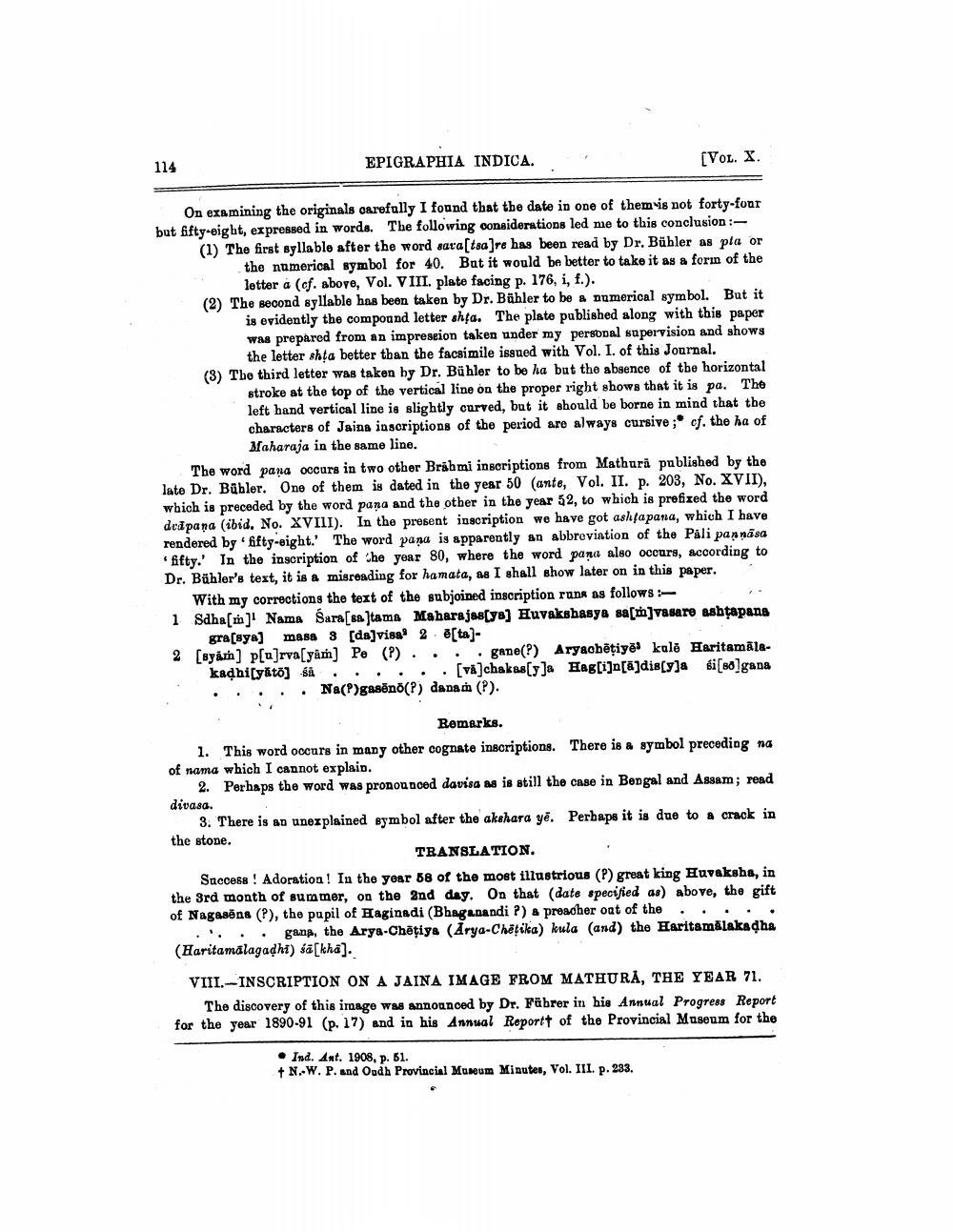________________
114
EPIGRAPHIA INDICA.
[VOL. X.
On examining the originals carefully I found that the date in one of them is not forty-four but fifty-eight, expressed in words. The following considerations led me to this conclusion:(1) The first syllable after the word sava [tsa]re has been read by Dr. Bühler as pla or the numerical symbol for 40. But it would be better to take it as a form of the letter a (cf. above, Vol. VIII. plate facing p. 176, i, f.).
(2) The second syllable has been taken by Dr. Bühler to be a numerical symbol. But it is evidently the compound letter shta. The plate published along with this paper was prepared from an impression taken under my personal supervision and shows the letter shta better than the facsimile issued with Vol. I. of this Journal.
(3) The third letter was taken by Dr. Bühler to be ha but the absence of the horizontal
stroke at the top of the vertical line on the proper right shows that it is pa. The left hand vertical line is slightly curved, but it should be borne in mind that the characters of Jaina inscriptions of the period are always cursive; cf. the ha of Maharaja in the same line.
The word pana occurs in two other Brahmi inscriptions from Mathura published by the late Dr. Bühler. One of them is dated in the year 50 (ante, Vol. II. p. 203, No. XVII), which is preceded by the word pana and the other in the year 52, to which is prefixed the word deapana (ibid. No. XVIII). In the present inscription we have got ashfapana, which I have rendered by fifty-eight.' The word pana is apparently an abbreviation of the Pali pannasa fifty. In the inscription of the year 80, where the word pana also occurs, according to Dr. Bühler's text, it is a misreading for hamata, as I shall show later on in this paper.
With my corrections the text of the subjoined inscription runs as follows:
1 Sdha[m] Nama Sara [sa]tama Maharajas[ya] Huvakshasya sa[m]vasare ashtapana gra[sya] masa 3 [da]visa 2 ē[ta]2 [syam] p[u]rva[yäm] Pe (?) . . kadhi yato] śà
gane(?) Aryachețiye kale Haritamala[VA]chakas[y]a Hag[i]n[a]dis[y]a si[s0]gana Na(?)gaseno(?) danam (?).
Remarks.
1. This word occurs in many other cognate inscriptions. There is a symbol preceding na of nama which I cannot explain.
2. Perhaps the word was pronounced davisa as is still the case in Bengal and Assam; read
divasa.
3. There is an unexplained symbol after the akshara ye. Perhaps it is due to a crack in
the stone.
TRANSLATION.
Success! Adoration! In the year 58 of the most illustrious (?) great king Huvaksha, in the 3rd month of summer, on the 2nd day. On that (date specified as) above, the gift of Nagasena (?), the pupil of Haginadi (Bhaganandi ?) a preacher out of the
gana, the Arya-Chetiya (Arya-Chētika) kula (and) the Haritamalakadha (Haritamalagaght) [k].
VIII. INSCRIPTION ON A JAINA IMAGE FROM MATHURA, THE YEAR 71.
The discovery of this image was announced by Dr. Führer in his Annual Progress Report for the year 1890-91 (p. 17) and in his Annual Reportt of the Provincial Museum for the
Ind. Ant. 1908, p. 51.
+ N.-W. P. and Oudh Provincial Museum Minutes, Vol. III. p. 233.




